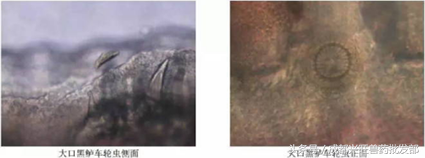Spring is coming, and all kinds of parasites are also beginning to be active, and there are many kinds of fish parasites, and most of them are conditionally pathogenic. Today we take a look at several common parasites. For parasite control, the main thing is to cut off the source of infection, maintain a good water quality substrate, and improve the fish's own immunity and resistance.
<h1> 1. Wheel worms</h1>
Rotifers are in the genus Ciliate Phylum, Order Phylloscopus, Family Rotiferidae. The wheelworm attaches to the gill or skin of the fish with an attachment disc and slides back and forth, sometimes leaving the host to swim freely in the water. It is endemic from April to July, and often parasitizes fish on gills and fins, and fry may have symptoms of "white head and white mouth" or "running horse" (swimming around continuously).

Prevention: Pay attention to inspection before releasing seedlings, the stocking density should not be too large, reduce the mechanical damage of the fish body, improve the immunity of the fish body, and maintain good water quality.
Treatment: Copper sulfate and ferrous sulfate combination (5:2) sprinkled in the whole tank, and then with the wheel, mandarin fish to kill wheel worms should be cautious.
<h1> 2. Gill mold</h1>
Gill mold invades the gills of the fish body and causes the onset of fish disease, which is gill mold disease. It usually occurs in May to October, with the peak incidence from June to July.
Prevention: Keep the water fresh frequently to prevent the deterioration of water quality, and regularly sprinkle 25ppm quicklime throughout the whole pool.
Treatment: Sprinkle with a clean pool of mold.
<h1> 3. Small melon worms</h1>
Small melon worms mainly parasitize the skin, fins, gills, head, mouth and eyes of fish, forming a small white dot-like sac that is visible to the naked eye.
Prevention: Regularly clean and disinfect cages, daily feeding should strengthen nutrition, improve the resistance of fish.
Treatment: Use betel nut medicine packs hanging around the cage for treatment, wash the cage before hanging bags, and use the drug treatment continuously according to the course of treatment.
<h1> 4. Tired branches</h1>
Individuals are bell-shaped, with straight, thick stalks, transparent and muscleless filaments, and group stalks that do not contract. Once epigenetic on the surface, appendages, eyes and gills of shrimp and crabs, it causes the onset of shrimp and crab disease, which is ciliate disease.
Prevention: Strict insecticidal disinfection of aquaculture water, reasonable feeding of feed and enhancement of fish body immune resistance.
Treatment: Use formalin and mixed killer pioneers to evenly sprinkle throughout the pool.
<h1> 5. Monotoclonal</h1>
Monotodra can ingest organic matter into the cell-eating organs to decompose, once epiphytic on the surface, appendages, eyes and gills of shrimp and crabs, thus causing shrimp and crab disease, that is, ciliate disease.
Prevention: Sprinkle quicklime once every half a month to keep the pool fat, live and cool for a long time.
Treatment: The whole pool is sprinkled with 1 ppm zinc sulfate.
<h1> 6. Ringworms</h1>
Ringworms are endemic in late spring and early summer at a suitable temperature of 20-25°C. In large amounts of parasitism, the gill filament mucus of the diseased fish increases, and the gill filament is swollen, pale, and anemia. The gills of the sick fish are open, have difficulty breathing, swim slowly and die. The main hazards are silver carp, bighead carp and grass carp, which are common when inspecting grass carp in the market.
Prevention: Soak with potassium permanganate for ten minutes before releasing seedlings, the stocking density is moderate, and the water quality is maintained.
Treatment: Whole pool spilled On Lord of the Rings.
Common parasites are introduced here, in the event of serious parasites, it is necessary to contact the local veterinarian or aquatic technology teacher in time, timely diagnosis and treatment, early detection and early treatment.